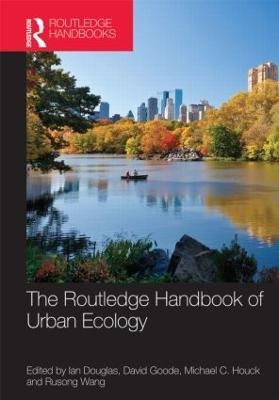
The Routledge Handbook of Urban Ecology
Routledge (Verlag)
978-0-415-49813-5 (ISBN)
- Titel erscheint in neuer Auflage
- Artikel merken
The birds, animals, insects, trees and plants encountered by the majority of the world’s people are those that survive in, adapt to, or are introduced to, urban areas. Some of these organisms give great pleasure; others invade, colonise and occupy neglected and hidden areas such as derelict land and sewers. Urban areas have a high biodiversity and nature within cities provides many ecosystem services including cooling the urban area, reducing urban flood risk, filtering pollutants, supplying food, and providing accessible recreation. Yet, protecting urban nature faces competition from other urban land uses.
The Handbook of Urban Ecology analyses this biodiversity and complexity and provides the science to guide policy and management to make cities more attractive, more enjoyable, and better for our own health and that of the planet. This Handbook contains 50 interdisciplinary contributions from leading academics and practitioners from across the world to provide an in-depth coverage of the main elements of practical urban ecology. It is divided into six parts, dealing with the philosophies, concepts and history of urban ecology; followed by consideration of the biophysical character of the urban environment and the diverse habitats found within it. It then examines human relationships with urban nature, the health, economic and environmental benefits of urban ecology before discussing the methods used in urban ecology and ways of putting the science into practice.
The Handbook offers a state-of the art guide to the science, practice and value of urban ecology. The engaging contributions provide students and practitioners with the wealth of interdisciplinary information needed to manage the biota and green landscapes in urban areas.
Ian Douglas is Emeritus Professor at the School of Environment and Development, University of Manchester, UK. David Goode is a Professor at the Environment Institute, University College London, UK. Michael C. Houck is Executive Director of Urban Greenspaces Institute, Portland, Oregon, USA. Rusong Wang is Deputy Director at State Key Lab of Urban and Regional Ecology, Research Center for Eco-Environmental Sciences, Chinese Academy of Sciences, China.
Part 1: Context, History and Philosophies Introduction 1. Urban Ecology: Definitions and Goals 2. The Analysis of Cities as Ecosystems 3. Urban Ecology and Industrial Ecology 4. Urban Areas in the Context of Human Ecology 5. In Livable Cities is Preservation of the Wild: The Politics of Providing for Nature in Cities 6. The Human Relationship with Nature: Rights of Animals and Plants in the Urban Context 7. Urban Natural Histories to Urban Ecologies: The Growth of the Study of Urban Nature 8. Planning for Nature in Towns and Cities: A Historical Perspective 9. How Much is Urban Nature Worth? And For Whom? Thoughts Fom Ecological Economics Part 2: The Urban Ecological Environment Introduction 10. Climate of Cities 11. Urban Heat Islands 12. Urban Effects on Precipitation and Associated Convective Processes 13. Urban Hydrology 14. Urban Geomorphology 15. Urban Soils 16. The Process of Natural Succession in Urban Areas 17. Recombinant Ecology of Urban Areas: Characterisation, Context and Creativity 18. Creative Conservation Part 3: The Nature of Urban Habitats Introduction 19. Walls and Paved Surfaces: Urban Complexes With Limited Water and Nutrients 20. Urban Cliffs 21. Suburban Mosaic of Houses, Roads, Gardens and Mature Trees 22. Urban Wildlife Corridors: Conduits for Movement or Linear Habitat? 23. Landscaped Parks and Open Spaces 24. Grassland on Reclaimed Soil, With Streets, Car Parks and Buildings but Few, or no, Mature Trees 25. Urban Contaminated Land 26. Urban Woodlands as Distinctive and Threatened Nature-in-City Patches 27. Wetlands in Urban Environments 28. Urban Animal Ecology 29. Feral Animals in the Urban Environment Part 4: Ecosystem Services and Urban Ecology Introduction 30. Intrinsic and Aesthetic Values of Urban Nature: The View From London 31. Intrinsic and Aesthetic Values of Urban Nature: A Psychological Perspective 32. Urban Nature and Human Physical Health 33. Urban Nature: Human Psychological and Community Health 34. Street Trees and the Urban Environment 35. Urban Gardens and Biodiversity Part 5: Methodologies Introduction 36. Urban Habitat Analysis 37. Urban Habitat Type Mapping 38. Invasive Species and Their Response to Climate Change 39. Urban Biogeochemical Flux Analysis 40. Urban Metabolism Analysis Part 6: Applications and Policy Implications Introduction 41. Delivering Urban Greenspace for People and Wildlife 42. Urban Areas and the Biosphere Reserve Concept 43. Urban Ecology and Sustainable Urban Drainage 44. Green Roofs, Urban Vegetation and Urban Runoff 45. The Role of Green Infrastructure in Adapting Cities to Climate Change 46. Creative Use of Therapeutic Green Spaces 47. Peri-Urban Ecology: Green Infrastructure in the Twenty-First Century Metro-Scape 48. Biodiversity as a Statutory Component of Urban Planning 49. Making Urban Ecology a Key Element in Urban Development and Planning 50. Towards Ecopolis: New Technologies, New Philosophies and New Developments. Conclusion
| Erscheint lt. Verlag | 17.12.2010 |
|---|---|
| Zusatzinfo | 47 Tables, black and white; 16 Line drawings, black and white; 50 Halftones, black and white; 36 Illustrations, black and white |
| Verlagsort | London |
| Sprache | englisch |
| Maße | 174 x 246 mm |
| Gewicht | 1430 g |
| Themenwelt | Naturwissenschaften ► Biologie ► Ökologie / Naturschutz |
| Technik ► Umwelttechnik / Biotechnologie | |
| Weitere Fachgebiete ► Land- / Forstwirtschaft / Fischerei | |
| ISBN-10 | 0-415-49813-9 / 0415498139 |
| ISBN-13 | 978-0-415-49813-5 / 9780415498135 |
| Zustand | Neuware |
| Informationen gemäß Produktsicherheitsverordnung (GPSR) | |
| Haben Sie eine Frage zum Produkt? |
aus dem Bereich



